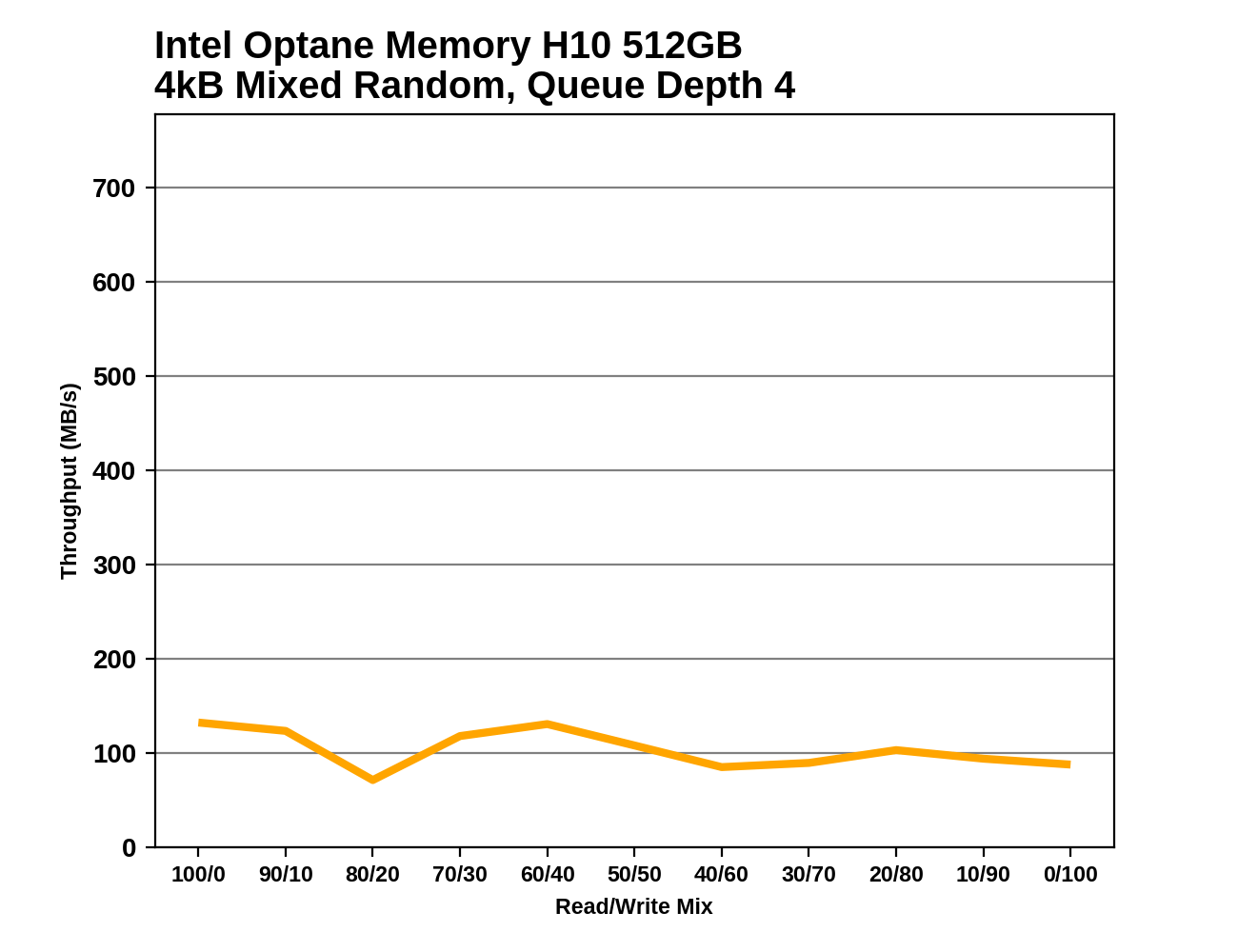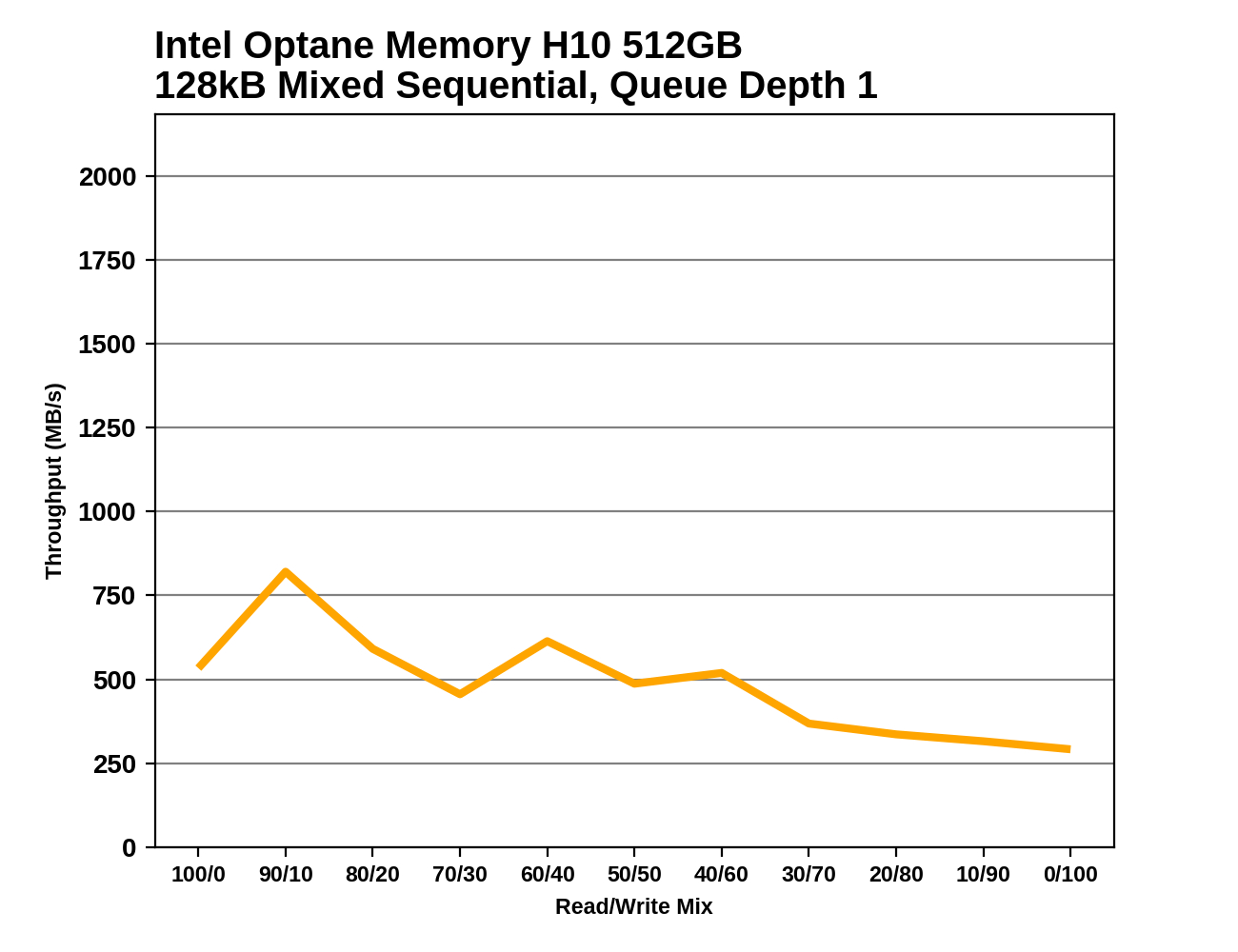The Intel Optane Memory H10 Review: QLC and Optane In One SSD
by Billy Tallis on April 22, 2019 11:50 AM ESTMixed Random Performance
Our test of mixed random reads and writes covers mixes varying from pure reads to pure writes at 10% increments. Each mix is tested for up to 1 minute or 32GB of data transferred. The test is conducted with a queue depth of 4, and is limited to a 64GB span of the drive. In between each mix, the drive is given idle time of up to one minute so that the overall duty cycle is 50%.

The performance of the Optane Memory H10 on the mixed random IO test is worse than either half of the drive provides on its own. The test covers a wider span than the 32GB Optane cache can handle, so the caching software's attempts to help end up being detrimental.
 |
|||||||||
The QLC portion of the H10 performs similarly to the Optane caching configuration during the read-heavy half of the test, though the caching makes performance less consistent. During the write heavy half of the test, the QLC-only configuration picks up significant speed over the Optane caching setup, until its SLC cache starts to run out at the very end.
Mixed Sequential Performance
Our test of mixed sequential reads and writes differs from the mixed random I/O test by performing 128kB sequential accesses rather than 4kB accesses at random locations, and the sequential test is conducted at queue depth 1. The range of mixes tested is the same, and the timing and limits on data transfers are also the same as above.

The Optane Memory H10 averages a bit better than SATA SSDs on the mixed sequential IO test, but there's a significant gap between the H10 and the high-end TLC-based drives. This is another scenario where the Optane caching software can't find a way to consistently help, and the H10's overall performance is a bit lower than it would have been relying on just the QLC NAND with its SLC cache.
 |
|||||||||
The caching software contributes to inconsistent performance for the Optane Memory H10 but the general trend is toward lower performance as the workload becomes more write heavy. The QLC portion on its own is able to increase speed during the second half of the test because it is quite effective at combining writes.










60 Comments
View All Comments
yankeeDDL - Monday, April 22, 2019 - link
Is it me or, generally speaking, it is noticeably slower than the 970 Evo?DanNeely - Monday, April 22, 2019 - link
The 970 can make use of 4 lanes, with only 2 effective lanes in most scenarios any good x4 drive is going to be able to smoke the H10.yankeeDDL - Monday, April 22, 2019 - link
I still remember that Optane should be 1000x faster and 1000x cheaper. It seems that it is faster, albeit by a much lower factor ... then why hamper it with a slower bus? I mean, I came to read the review thinking that it could be a nice upgrade, and then I see it beaten handily by the 970 Evo. What's the point of such device? It is clearly more complex, so I doubt it'll be cheaper than the 970 Evo...Alexvrb - Monday, April 22, 2019 - link
Wait, did they say it would be cheaper? I don't remember that. I know they thought it would be a lot faster than it is... to be fair they seemed to be making projections like NAND based solutions wouldn't speed up at all in years LOL.It can be a lot faster in certain configs (the high end PCIe add-on cards, for example) but it's insanely expensive. Even then it's mainly faster for low QDs...
kgardas - Tuesday, April 23, 2019 - link
Yes, but just in comparison with DRAM prices. E.g. NVDIMM of big size cheaper than DIMM of big size.Irata - Tuesday, April 23, 2019 - link
It was supposed to be 1000x faster and have 1000x the endurance of NAND as per Intel's official 2016 slides.It may be slightly off on those promises - would have loved for the article to include the slide with Intel's original claims.
Price wasn't mentioned.
yankeeDDL - Tuesday, April 23, 2019 - link
You're right. They said 1000x faster, 1000x endurance and 10x denser, but they did not say cheaper, although, the 10x denser somewhat implies it (https://www.micron.com/~/media/documents/products/... Still, this drive is not faster, nor it has significantly higher endurance. Let's see if it is any cheaper.Valantar - Tuesday, April 23, 2019 - link
Denser than DRAM, not NAND. Speed claims are against NAND, price/density claims against DRAM - where they might not be 1/10th the price, but definitely cheaper. The entire argument for 3D Xpoint is "faster than NAND, cheaper than DRAM (while persistent and closer to the former than the latter in capacity)", after all.CheapSushi - Wednesday, April 24, 2019 - link
I think this is why there's still negative impressions around 3D Xpoint. Too many people still don't understand it or confuse the information given.cb88 - Friday, May 17, 2019 - link
Optane itself is *vastly* faster than this... on an NVDIMM it rivals DDR4 with latencies in hundreds of ns instead of micro or milliseconds. And bandwidth basically on par with DDR4.I think it's some marketing BS that they don't use 4x PCIe on thier M.2 cards .... perhaps trying to avoid server guys buying them up cheap and putting them on quad m.2 to PCIe adapters.